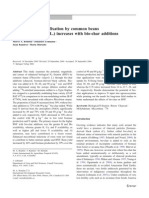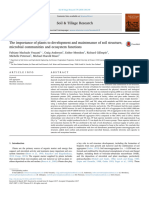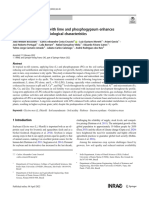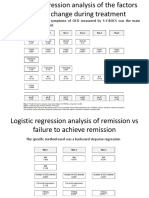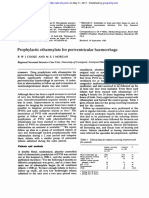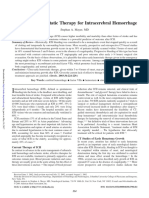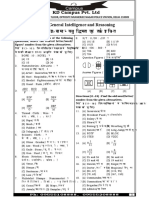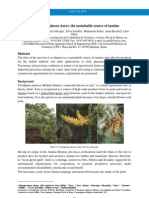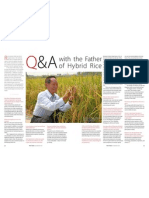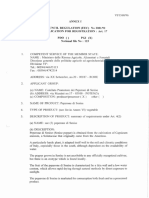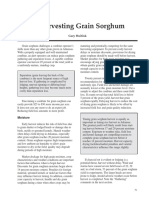Organic Material Decomposition and Nutrient Dynamics in A Mulch System Enriched With Leguminous Trees in The Amazon
Organic Material Decomposition and Nutrient Dynamics in A Mulch System Enriched With Leguminous Trees in The Amazon
Uploaded by
novywardanaCopyright:
Available Formats
Organic Material Decomposition and Nutrient Dynamics in A Mulch System Enriched With Leguminous Trees in The Amazon
Organic Material Decomposition and Nutrient Dynamics in A Mulch System Enriched With Leguminous Trees in The Amazon
Uploaded by
novywardanaOriginal Description:
Original Title
Copyright
Available Formats
Share this document
Did you find this document useful?
Is this content inappropriate?
Copyright:
Available Formats
Organic Material Decomposition and Nutrient Dynamics in A Mulch System Enriched With Leguminous Trees in The Amazon
Organic Material Decomposition and Nutrient Dynamics in A Mulch System Enriched With Leguminous Trees in The Amazon
Uploaded by
novywardanaCopyright:
Available Formats
ORGANIC MATERIAL DECOMPOSITION AND NUTRIENT DYNAMICS IN A MULCH SYSTEM...
1073
ORGANIC MATERIAL DECOMPOSITION AND NUTRIENT
DYNAMICS IN A MULCH SYSTEM ENRICHED WITH
LEGUMINOUS TREES IN THE AMAZON(1)
Jos Henrique Cattanio(2), Ronald Kuehne(3) & Paul L.G. Vlek(4)
SUMMARY
The new techniques proposed for agriculture in the Amazon region include
rotational fallow systems enriched with leguminous trees and the replacement of
biomass burning by mulching. Decomposition and nutrient release from mulch
were studied using fine-mesh litterbags with five different leguminous species
and the natural fallow vegetation as control. Samples from each treatment were
analyzed for total C, N, P, K, Ca, Mg, lignin, cellulose content and soluble polyphenol
at different sampling times over the course of one year. The decomposition rate
constant varied with species and time. Weight loss from the decomposed litter bag
material after 96 days was 30.1 % for Acacia angustissima, 32.7 % for Sclerolobium
paniculatum, 33.9 % for Iinga edulis and the Fallow vegetation, 45.2 % for Acacia
mangium and 63.6 % for Clitoria racemosa. Immobilization of N and P was observed
in all studied treatments. Nitrogen mineralization was negatively correlated with
phenol, C-to-N ratio, lignin + phenol/N ratio, and phenol/phosphorus ratios and
with N content in the litterbag material. After 362 days of field incubation, an
average (of all treatments), 3.3 % K, 32.2 % Ca and 22.4 % Mg remained in the mulch.
Results confirm that low quality and high amount of organic C as mulch application
are limiting for the quantity of energy available for microorganisms and increase
the nutrient immobilization for biomass decomposition, which results in
competition for nutrients with the crop plants.
Index terms: contrasting chemical compositions, nutrient mineralization; nutrient
immobilization; litterbags.
(1)
Recebido para publicao em maro de 2006 e aprovado em fevereiro de 2008.
(2)
Professor da Faculdade de Meteorologia, Universidade Federal do Par UFPA. Campus Universitrio do Guam, Rua
Augusto Corra 1, Instituto de Geocincias - Campus Bsico, CEP 66075-110 Belm (PA). E-mail: cattanio@ufpa.br
(3)
Colaborador do Institute of Agriculture in the Tropics (IAT), University of Goettingen, Grisebachstr. 6, 37077 Goettingen,
Alemanha. E-mail: rkuehne@gwdg.de
(4)
Professor do Center for Development Research (ZEF), Walter Flex Str. 3, 53113 Bonn, Alemanha. E-mail: pvlek@uni.bonn
R. Bras. Ci. Solo, 32:1073-1086, 2008
1074 Jos Henrique Cattanio et al.
RESUMO: DECOMPOSIO DE MATERIAL ORGNICO E DINMICA DE
NUTRIENTES EM UM SISTEMA DE COBERTURA MORTA
ENRIQUECIDO COM RVORES LEGUMINOSAS NA AMAZNIA
As novas tcnicas propostas para a agricultura na Amaznia incluem sistema de
rotao de capoeira enriquecido com rvores leguminosas e transformando a queima da
biomassa em cobertura morta sobre o solo. A decomposio e a liberao de nutrientes da
cobertura morta foram estudadas usando sacos de liteira com malha fina que continham
cinco tratamentos com diferentes espcies de leguminosas em comparao a um tratamento-
controle com vegetao natural. As amostras para cada tratamento foram analisadas
para contedos de C total, N, P, K, Ca, Mg, lignina, celulose e polifenis solveis em
diferentes tempos de amostragem durante um ano. A razo constante de decomposio
variou com a espcie e com o tempo. A perda de massa nos sacos de decomposio foi de
30,1 % para Acacia angustissima, de 32,7 % para Sclerolobium paniculatum, de 33,9 %
para Inga edulis e para a vegetao secundria, de 45,2 % para Acacia mangium e de
63,6 % para Clitoria racemosa . Foi observada imobilizao de N e P em todos os
tratamentos, sendo a mineralizao do N negativamente correlacionada com o fenol, razo
C/N, razo (lignina + fenol)/N, razo fenol/P e o contedo de N nos sacos de liteira. Depois
de 362 dias de incubao no campo, 3,3 % de K, 32,2 % de Ca e 22,4 % de Mg permaneceram
no material em decomposio. Os resultados evidenciaram que a baixa qualidade mineral
e a alta quantidade de carbono orgnico e aplicado como cobertura morta podem limitar a
quantidade de energia disponvel para os microrganismos resultando em uma competio
por nutrientes com as plantas agrcolas.
Termos de indexao: composio qumica contrastantes, mineralizao de nutrientes,
imobilizao de nutrientes, sacos de liteira.
INTRODUCTION Organic resources play an essential role in soil
fertility management in the tropics by their short-
Fallow vegetation plays an important role in term effects on nutrient supply and longer-term
maintaining or restoring soil productivity in the slash- contribution to soil organic matter (SOM) formation
and-burn agriculture system of the Amazon basin. (Palm et al., 2001). The decomposition rate and the
However, the intensification of land use has drastically amount of nutrient release from organic matter (OM),
reduced the fallow period. Therefore, the soil quality particularly from leguminous trees, determine the
has to be restored in a shorter time period. This could short-term benefits of tree residues for crop nutrition
be accomplished by the introduction of intensified (Handayanto et al., 1997). Resource quality
forms of fallow management such as planted or parameters and indices related to decomposition and
enriched fallow systems (Brienza Jr., 1999), which nutrient release in natural ecosystems were described
are modifications of the slash-and-mulch systems. by Swift et al. (1979), Schlesinger & Hasey (1981)
and Melillo et al. (1982). Numerous studies have since
For research in applied soil biology, the reported on nutrient contents, resource quality,
synchronization of nutrient release from organic decomposition, and nutrient release patterns for a
material and the plant nutrient uptake are a topic of variety of organic materials in tropical agroecosystems
great interest in cases where burning is replaced by (Palm, 1995; Cadisch & Giller, 1997; Heal et al., 1997;
biomass mulching, (Addiscott et al., 1991; Myers et Mafongoya et al., 1998).
al., 1994). Furthermore, the existence and extent of
plant-microbe competition for inorganic and organic The decomposition rates and N release in
N and P resources need to be elucidated (Kaye & Hart, leguminous plant residues with high N content are
1997). Crop yields in the project area (Eastern usually high (Swift et al., 1979; Ladd et al., 1981,
Amazon, Brazil) following slash-and-mulch fall short Hunt et al., 1988; Constantinides & Fownes, 1994a).
of those after burning, which is ascribed to a lack of Contents of N, lignin and polyphenol are chemical
nutrients (Denich et al., 2004). In order to project factors that control the degradation of plant materials
more efficient agricultural systems, there should be in the soil (Constantinides & Fownes, 1994a). In
a clear understanding of the determinants of nutrient general, increasing lignin concentration reduces the
supply, especially those that condition nutrient release residue decomposition rate (Meentemeyer, 1978; Tian
from plant residues (Seneviratne, 2000). et al., 1992; Moorhead et al., 1996). High lignin
R. Bras. Ci. Solo, 32:1073-1086, 2008
ORGANIC MATERIAL DECOMPOSITION AND NUTRIENT DYNAMICS IN A MULCH SYSTEM... 1075
contents could also enhance nutrient immobilization, MATERIAL AND METHODS
especially of N (Melillo et al., 1982). However, Vallis
& Jones (1973) and Palm & Sanchez (1991) found that
The experimental area was near Igarap-A, in
N release patterns are more dependent on polyphenol
the Northeast of the State of Par, in the Amazon
content. Furthermore, the initial lignin:N ratios and
region. The largely deforested area is dominated by
the lignin + polyphenol:N ratios were strongly
subsistence crop production of small holders who use
correlated with the N mineralization rates or N
accumulation (Handayanto et al., 1997). a shifting cultivation system. The strongly weathered
soils of the region are typical Kandiudults (USDA Soil
In many soils, P availability is heavily restricted Taxonomy) with the following surface soil properties
by binding to Fe and Al oxides and by the fact that it (020 cm): 1.6 g kg-1 total C, 0.13 g kg-1 total N,
moves through the soil profile by diffusion rather than 1.3 mg kg-1 total P, 5.5 pH. The sand soil texture is
with flowing water. Only a small fraction of the 820 g kg-1 sand, 180 g kg-1 clay at 1.3 g cm-3 density.
organic P pool (about 1 % per year), is mineralized, Total rainfall ranges from 2.000 to 3.000 mm year-1
supplying inorganic P for plant uptake (Tiessen et with three months of sparse rain (September-
al., 1984). Organic P transformation in the soil is November). Annual temperature averages between
difficult to study because of the reaction of inorganic 2527 C, and relative humidity is 8090 %.
P with various soil minerals. In most ecosystems the
P available for biogeochemical cycling is contained in The decomposition study was conducted for one
organic forms (Chapin et al., 1978; Wood et al., 1984; year (19971998), after slashing and mulching the
Yanai 1992; Gressel et al., 1996). Quality factors standing aboveground biomass of a 30-month-old
known to control P availability patterns of organic experimental stand to investigate the dynamics of
inputs are total P, C/P and N/P ratios (Singh & Jones, fallow vegetation enriched with the following
1976; Vogt et al., 1986), which are highly variable in leguminous tree species: Acacia mangium Willd (total
terms of the critical levels. Net mineralization of P aboveground biomass = 55.6 Mg ha-1), A. angustissima
from organic matter usually begins at C/P ratios < Kuntze (33.5 Mg ha-1), Sclerolobium paniculatum
200 (Schlesinger, 1997). Vogel (32.2 Mg ha-1), Inga edulis Mart. (30.0 Mg ha-1),
Across large areas in the tropics of particularly and Clitoria racemosa G. Don (27.2 Mg ha-1) (Brienza
Oxisols the K, Ca and Mg supplies for crop needs are Jr., 1999). Secondary forest regrowth was used as
low (Brady, 1990). Plant residues can be an essential control (24.0 Mg ha-1), but the regrowth being an
source of these nutrients. Information on K, Ca and enrichment with leguminous species this also finds
Mg release patterns can therefore be used to predict in the other treatments. Samples of bulked fresh
the potential of plant residues as sources of these material were collected from the five leguminous-
nutrients. However, information about these elements species treatments with presumably contrasting litter
is scarce. quality characteristics and one mixed sample from
the control (Table 1).
The objective of this paper is to report results from
studies on different mulch decomposition and release Residue decomposition and nutrient release were
patterns of N, P, K, Ca and Mg in natural fallow studied using fine-mesh litterbags (11 x 9 cm, mesh-
systems enriched with a legume tree species (Acacia size < 0.2 cm). About 25 g of ground air-dried
angusticima , A. mangium, Clitoria racemosa, material (> 0.2 cm, equivalent to 25 Mg ha-1) per
Sclerolobium paniculatum or Inga edulis), and natural leguminous tree were placed in each bag. The
fallow vegetation alone (control). These fallow systems quantity of biomass included in the litterbags was
are being evaluated in search for alternatives to the calculated in Mg ha-1, based on the production results
existing slash-and-mulch agriculture in the Amazon of Brienza Jr. (1999) and the bag surface area. In this
region. way, treatment levels included five pure leguminous
Table 1. Initial chemical composition of litterbag material from different leguminous species and control
(fallow vegetation) used in the decomposition experiment. Average(stand error)
R. Bras. Ci. Solo, 32:1073-1086, 2008
1076 Jos Henrique Cattanio et al.
species and a mixture of spontaneous regrowth materials analyzed. In the control treatment the
(control). initial N concentration was highest and the initial
concentration in K, Mg, cellulose and phenol lowest.
Nine litterbags per treatment for each time (total The I. edulis treatment had the highest initial K and
per treatment = 36) were placed randomly on three of Ca concentration, and S. paniculatum the highest
the 10 x 8 m plots, where the same species had grown initial lignin concentration.
before felling the trees. Care was taken that the
litterbags were covered by chopped material. In order Because all treatments had initial C:N ratios of
to test the external influence of the organic material more than 40, an initial nutrient immobilization was
from remaining mulch, three litterbags per sampling to be expected (Stevenson and Cole 1999). Nutrients
date were placed outside the plot without mulch such as N, which are often limiting for microbial
contact. The residue litterbags were removed, brushed growth, are immobilized where C supply is plentiful
free of foreign material (including roots) and dried 0, and nutrient concentrations are low and mineralized
6, 12, 24, 48, 96, and 362 days after the beginning of as C content decreases and nutrient concentration
the experiment. increases (Stevenson and Cole 1999).
The dry matter content and all parameter analyses
Patterns of organic matter decomposition
were corrected for ash content (Blair et al., 1990). The
samples from each treatment were ground and A rapid decrease in ash-free dry weight was
analyzed for total C and N by analyzer Carlo Erba observed in C. racemosa and A. mangium prunings
(Carlo Erba elementary analysis). For the during 96 days of field incubation (Figure 1). The A.
determination of P, K, Ca and Mg the materials were mangium treatment lost weight faster in the first
wet-digested with a mixture of HClO 4-HNO 3 . week of the experiment, but was slower than C.
Phosphorus was measured colorimetrically by an auto- racemosa thereafter. No significant differences
analyzer, K was measured by flame photometry, and (p > 0.05) in decomposition rates were observed
Ca and Mg were measured using atomic absorption between A. angustissima, S. paniculatum, I. edulis,
spectrophotometry (IITA, 1982). Lignin and cellulose and the control (fallow vegetation).
content was measured using the acid detergent fibre After 362 days the litterbag weight was reduced
method (van Soest & Wine, 1968), and soluble due to decomposition by 64.9 % (A. angustissima),
polyphenolics by the revised Folin-Denis method 71.7 % (I. edulis), 73.8 % (S. paniculatum), 78.9 %
(Constantinides & Fownes, 1994b). The tissue:solvent (control), 86.3 % (A. mangium ), and 97.0 % (C.
ratio of 1 mg mL-1 was extracted with 50 % methanol racemosa) (Figure 1). Weight losses of C. racemosa
at approximately 80 C for one hour. and A. mangium (Figure 1) differed significantly from
Ash-free dry weight of remaining plant material each other (p > 0.05, n = 316) and also when each
and decomposition rate constants were analyzed using was compared to the other three species ( A.
one-way analysis of variance (one-way ANOVA) and angustissima, S. paniculatum, I. edulis, and control).
multivariate analysis to determine differences in The differences in total weight losses in S.
decomposition (i.e. correlation, multiple regression and paniculatum, I. edulis and the control treatment were
principal components discriminate analysis methods). not significant. The biomass loss from A. mangium
Single (At = e-kt) and double [At = S e-kt + (1-S) e-ht] was significantly higher, approximately 48.0 Mg ha-1,
exponential equations were used to calculate the
decomposition rate constants (Wieder & Lang, 1982),
where At is the proportion of remaining material at
time t; S is the initial proportion of labile material;
(1-S) is the initial resistant proportion; k is the rate
constant for the labile component; and h is the rate
constant for resistant component. All statistical
analyses were performed using the SYSTAT program.
RESULTS AND DISCUSSION
Chemical composition of fallow species
The nutrient contents of the material in the
litterbags (Table 1) were variable. A. angustissima
contained the highest initial concentration of P,
cellulose and phenol and the lowest Ca and lignin Figure 1. Remaining dry mater (DM) in litter bags of
concentration. A. mangium had the highest initial residues of five leguminous species and fallow
Ca and Mg, and the lowest N and P concentration. vegetation (control) during decomposition
C. racemosa had intermediate concentrations of all period. Bars represent stand error.
R. Bras. Ci. Solo, 32:1073-1086, 2008
ORGANIC MATERIAL DECOMPOSITION AND NUTRIENT DYNAMICS IN A MULCH SYSTEM... 1077
since after 2.5 fallow years the aboveground biomass initial N decline (06 days) was observed for A.
of this species was 2.3 times greater than the natural angustissima only. Nitrogen accumulations depended
fallow vegetation (Brienza Jr., 1999). On the other significantly on the species and decomposition period.
hand, at the end of the experiment the remaining The N content remained stable during the first 96 days
mulch biomass of C. racemosa was the lowest with of field decomposition in A. mangium, I. edulis and
0.9 Mg ha-1 (3.3 % of initial mulch biomass). the control and thereafter decreased slightly in I. edulis
Exponential curves fitted well to the decomposition only (Figure 2). The N accumulation of A. mangium
data of each species (Table 2). The double exponential was highly significant until 96 days of litter bag
curve fit best with data for C. racemosa and A. incubation and dropped abruptly afterwards.
mangium (Pearson correlation coefficient = 0.951 for Immobilization of N in litterbag material was also
both species). The data for all species studied as well observed in litterbags without contact with the
as the control fitted best to a double exponential curve remaining mulch after 96 days of field decomposition
during the first week of the litterbag decomposition (data not shown). Increases in N mass in decomposing
experiment (Table 2). Although differences between litter of diverse wood species have been reported by
the two models were not significant, the double Melillo et al. (1982), Hunt et al. (1988), OConnell
exponential curve was better correlated with fast OM (1988), Blair et al. (1990), Constantinides & Fownes
decomposition, and the slow mass loss was better (1994a), and Vitousek et al. (1994). The reasons
correlated with the single exponential curve (Table 2). explaining the absolute increases include additions of
The exponential weight loss pattern agrees with N through one or more of the subsequent mechanisms:
the assumption that residues contain labile and fixation, absorption of atmospheric ammonia,
recalcitrant fractions with different degrees of throughfall, dust, insects, grass, green litter, fungal
resistance to microbial degradation. Reinerstsen et translocation and/or immobilization, bacterial
al. (1984) associated the more rapid decay immediately development. Nutrients such as N, which are often
after residue burial with the decomposition of water- limiting to microbial growth, are immobilized when
soluble organic contents. Hunt et al. (1988) explained the C supply is plentiful and nutrient concentrations
differences in decomposition patterns and rates among are low and mineralized when C content decreases
substrates as related to the amount of labile or rapidly and nutrient concentration increases (OConnell,
decomposing fractions (sugar, starches, proteins) and 1988).
the recalcitrant or slowly decomposing fraction The coefficients of correlation between N
(cellulose, lignin, fats, tannins, and waxes). accumulation or loss in litter bag material and some
chemical properties of OM are shown in table 3. The
Nitrogen and carbon release leguminous species and the control have different
patterns of N accumulation or loss, depending on the
The decomposition patterns of ash-free N release lignin:P ratio (k = 0.850). Nitrogen accumulation or
was different in different leguminous plant residues decrease in the litterbag was positively correlated with
(Figure 2). The increase of absolute N mass in the lignin content in most of the treatments. Only for A.
litterbags of all leguminous species studied as well as mangium and I. edulis, with a higher initial phenol
the control differed throughout the study period. An concentration, N accumulation was negatively
correlated with phenol.
All treatments were significantly negatively
Table 2. Correlation coefficients for single (At = e-k t)
correlated with phenol content and N accumulation
and double (At = S e-k t + (1-S) e-h t) exponential
or decrease in litterbag material. The ratios C:N and
equation that were used to calculate the
(lignin + phenol):N were highly significantly
decomposition rate constants, where At is the
correlated with N accumulation. The correlation of
proportion of material remaining at time t; S is
the initial proportion of labile material; (1-S) is
A. angustissima, A. mangium, and S. paniculatum
the initial proportion of resistant material; k is
was significant positive between N accumulation and
the rate constant for the labile component; and h P whereas the correlation of I. edulis was significant
is the rate constant for the resistant component negative. The S. paniculatum treatment had a
significant positive correlation between N
accumulation and P and I. edulis a significant
negative correlation for the same parameters. The
control and C. racemosa were not significantly
correlated with P.
Berendse et al. (1987) and Muller et al. (1988)
reported that N release was reduced at high lignin
concentrations. Lignin is known to be a recalcitrant
substance and highly resistant to microbial
decomposition (Melillo et al., 1982). This study,
however, showed that the species with a higher initial
R. Bras. Ci. Solo, 32:1073-1086, 2008
1078 Jos Henrique Cattanio et al.
Figure 2. Remaining N and C in litter bags material during decomposition experiment for five leguminous
species and a fallow vegetation (control). Bars represent stand error.
Table 3. Coefficients of determination (r2) for linear regressions between initial substrate quality variables
from some legumes species and natural fallow vegetation (as control) and N mineralization rate constants
after one year of field decomposition
ns
: not significant; *; significant at p < 0.05; and **
: significant at p < 0.01.
lignin concentration (S. paniculatum, Fallow and A. with two phenolic hydroxyls could fix N, part of which
angustissima) (Table 1) were positively correlated with was resistant to 72 % sulphuric acid or strong alkaline
N release in mulch. It has also been found that lignin solution (Bennett, 1949).
R. Bras. Ci. Solo, 32:1073-1086, 2008
ORGANIC MATERIAL DECOMPOSITION AND NUTRIENT DYNAMICS IN A MULCH SYSTEM... 1079
Phosphorus remaining in mulch
The remaining P decreased during the first week
of litterbag exposure in all treatments (Figure 3). But
after three weeks, P immobilization increased
significantly in all treatments (Figure 3). Phosphorus
immobilization may be due to the low initial P
concentrations in plant residues (Buldeman, 1998).
Some authors have shown that the release of P is
limited in many tropical soils and is often the most
limiting nutrient (Palm & Sanchez, 1990; Tian et al.,
1992; Thomas & Asakawa, 1993). Usually during
fallow, immobilization phases that could aggravate
soil solution P deficiencies relative to crop demand
(Palm, 1995). This study confirms that a potential
increase of P availability due to release from
decomposing plant residues could be an important
criterion for selecting species for enriched fallow
systems.
As also found by Kato (1998) at the same
experimental site, our study showed that the low P
content in the control and legume material resulted
in a high C:P ratio (Figure 4). The C:P ratios in the
A. angustissima , S. paniculatum and I. edulis
treatments increased in the first seven weeks of the
experiment. For the other treatment the C:P ratio
was constant during the experiment. Sanchez (1976)
showed that C:P and C:N ratios are indicators of P
deficiency and suggest that P is mineralized at about Figure 3. Percentages of P remaining in mulch from
the same rate as organic C. This hypothesis was different enriched legumes trees and natural
confirmed in the case of A. mangium, C. racemosa fellow as control, for 48 and 362 days of incubation
and the control treatment, but not for S. paniculatum period. Bars represent LSD with p < 0.05.
and I. edulis.
Figure 4. Carbon-to-P ratio and N-to-P ration for different legume treatment and control (as natural fallow
vegetation), for 48 and 362 days of incubation period.
R. Bras. Ci. Solo, 32:1073-1086, 2008
1080 Jos Henrique Cattanio et al.
In all treatments the N:P ratio increased during Remaining potassium in mulch
the incubation period (Figure 4). The decrease in the
N:P ratio in I. edulis and S. paniculatum was higher The patterns for K mineralization were different
after 96 incubation days. The increasing N:P ratios in the mulch material from different legume species
during decomposition imply that organic P was and the control (Figure 5). The K release in all
mineralized at a slower rate than organic N. Fungal treatments was fast, mainly in the case of I. edulis
translocation and/or immobilization may be the and C. racemosa, which lost approximately 80 % of
processes that increased P in the remaining mulch. the initial K in the first three weeks of field
decomposition. At the end of the incubation period
the release of remaining K in mulch biomass was very
low for all legume species and the control. However,
the remaining K in the control treatment was highest
in comparison with the other treatments.
Potassium in plants occurs mainly in a soluble
ionic form (Tukey, 1970). The cell structure of the
organs included in the mulch is largely lost.
Potassium can therefore be easily leached from litter
and the losses are certainly accelerated by high rainfall.
Potassium release from mulch is rather fast since
93.1 to 99.6 % of initial K concentration returns to
the soil during the first year of decomposition. At the
end of the experiment there were no significant
differences among the treatments
In general, K losses were highly positively
correlated with phenol and C concentration during
the incubation period across all treatments (Table 4).
This suggests that K mineralization dependeds on
phenol and C concentration during the incubation
period. However, the coefficient of correlation with K
concentration of P was higher for control and I. edulis
treatment. The initial K concentration in these
treatments was lowest and highest (Table 1),
respectively.
Calcium remaining in mulch
Release of Ca from all treatments increased during
incubation (Figure 6). Only in the A. angustissima
and I. edulis treatments there was no initial Ca
immobilization, and a significantly higher increase
Figure 5. Percentages of K remaining in mulch from was observed in the control and S. paniculatum
different enriched legumes trees and natural treatments. At the end of incubation, Ca release in
fellow as control, for 48 and 362 days of incubation A. angustissima was significantly lower than in the
period. Bars represent LSD with p < 0.05. other treatments.
Table 4. Correlation coefficients from regressions of potassium concentration (g kg-1) and remaining dry
matter (g) and some chemical properties (g kg-1 DM) during the incubation period. n = 54
R. Bras. Ci. Solo, 32:1073-1086, 2008
ORGANIC MATERIAL DECOMPOSITION AND NUTRIENT DYNAMICS IN A MULCH SYSTEM... 1081
into fungal hyphae as documented by Cromack et al.
(1978) and Swift et al. (1981). This would be consistent
with microbial immobilization of N and P as shown
above. Normally, when all treatments were
considered, the positive correlation of Ca losses with
N and Mg concentration was higher during the
incubation period (Table 5).
Magnesium remaining in mulch
Similarly as shown above, the patterns of Mg
release from mulch material were different in
treatments and control (Figure 7). Only in the control
and S. paniculatum Mg accumulation was significantly
higher during the first week of field decomposition.
In the A. angustissima, C. racemosa, I. edulis and A.
mangium treatments Mg release was highest during
the 14 weeks of incubation period. But at the end of
the experiment, the Mg concentration was only lower
than 20 % of the initial concentration in C. racemosa
(2.5 %) and A. mangium (8.1 %) (Figure 7).
Generally, the Mg losses were positively correlated
with N and Ca concentration during the incubation
period (Table 6).
As shown earlier by Swift et al. (1981), the patterns
of nutrient loss from litterbags are contrasting for
different organic matter quality. This indicates a
complex interplay of different processes during mulch
decomposition. The role of microorganisms in mulch
decomposition and nutrient immobilization is very
important. Also, the amount of nutrients released
Figure 6. Percentages of Ca remaining in mulch from depends on the intrinsic material quality and the
different enriched legumes trees and natural amount of organic materials in the mulch.
fellow as control, for 48 and 362 days of Nitrogen, P, Ca and Mg release from plant residues
incubation period. Bars represent LSD with followed different decomposition patterns. Nitrogen
p < 0.05. release rates varied with species and amount of plant
residues. The N mineralization patterns of the plant
material closely reflected the differences in their
The same slow Ca release in approximately the chemical composition. In all species studied, including
first 14 weeks of incubation was reported by Swift et the control (natural fallow vegetation) N was
al. (1981), which is however contradictory to results immobilized at some time during decomposition.
of Tian et al. (1992), except in the case of Acio, where Furthermore, the increase in N concentration does
no Ca was released. The net accumulation period for not seem to have been influenced by the remaining
Ca is probably due to luxury uptake of this element material, because litterbags without remaining mulch
Table 5. Correlation coefficients from regressions of calcium concentration (g kg-1) and remaining dry matter
(g) and some chemical properties (g kg-1 DM) during the incubation period. n = 54
R. Bras. Ci. Solo, 32:1073-1086, 2008
1082 Jos Henrique Cattanio et al.
Some suggestion can be formulated to explain the
increases in N concentration during decomposition
in the litterbags. High polyphenol and lignin
concentrations (Figure 9) may be a major factor in N
immobilization during decomposition. Leaching of a
major fraction of soluble polyphenol in mulch might
be responsible for the formation of stable polymers
with many N forms. This results in N immobilization
often restricts microbial growth; this nutrient is
immobilized when the C supply is plentiful and
nutrient concentrations are low. Therefore, N is
mineralized as the C content decreases and nutrient
concentrations increase.
All treatments showed a fast initial decrease in P
concentration during the first week of the incubation
period but ended with an increase in P at the end of
experiment. This indicates some initial P
immobilization in all plant residues that may be due
to the low initial P concentration in plant residues
and the suggested higher microorganism activity in
mulch (principally fungal growth, which can
translocate this element from soil to mulch). By the
end of the experiment, on average (pooled over all
treatments), 3.3 % 0.9 (mean STE), 32.2 % 6.7,
and 22.4 % 5.6 initial K, Ca and Mg, respectively,
remained in the mulch after 362 days of field
Figure 7. Percentages of Mg remaining in mulch from
incubation. Palm & Sanchez (1990), Thomas &
different enriched legumes trees and natural
Asakawa (1993) and Lupwayi & Haque (1999) reported
fellow as control, for 48 and 362 days of
greater loss of K than of any other nutrient from
incubation period. Bars represent LSD with
decomposing leguminous tree litter and immobilization
p < 0.05.
of Ca and Mg. Furthermore, Tian et al. (1992)
observed a more rapid release of K than of the other
nutrients, although Ca and Mg release fast as well.
also showed an increase in N concentration during
the decomposition period. Carbon:N ratios and In accordance with Palm & Sanchez (1991), the
polyphenol:P ratios appeared better correlated with use of legume trees with low polyphenol content as
N immobilization for all species and the control mulch can release N and provides this nutrient for
vegetation. The data suggest that Mg, lignin and Ca crop growth. Legumes with high levels of polyphenols
were strongly correlated with N immobilization that may react with organic N compounds are not
(Figure 8). The importance of Ca and Mg for P favorable for adequate N levels for plant growth in
maintenance in mulch material seems to be due to the short term. However, they may contribute to the
nutrient deficiencies in acid soils and the competition build-up of soil organic N and result in a low but
for these elements between microorganism absorption continuous N supply in the long term. From our
and soil adsorption. results it appears that the mixing of two contrasting
Table 6. Correlation coefficients from regressions of magnesium concentration (g kg-1) and some chemical
properties (g kg-1 DM) during the incubation period. n = 54
R. Bras. Ci. Solo, 32:1073-1086, 2008
ORGANIC MATERIAL DECOMPOSITION AND NUTRIENT DYNAMICS IN A MULCH SYSTEM... 1083
Figure 8. The better correlation of some nutrients and mulch characteristics: N content with Mg content
(a), Ca content (b) and lignin content (c), and correlation of phosphorus content and Ca content. The
correlation was made during the incubation time of litterbag with different material content.
The need of increasing agricultural yields cannot
be met by a major expansion of cultivated areas alone,
so the intensification of land use and improvement of
currently cultivated soil is indispensable. An enriched
fallow management with slash and mulch system can
be an option to restore soil organic matter and
maintain nutrients in the humid tropical ecosystem.
Studies of systems enriched with contrasting
leguminous species in terms of nutrient mineralization
and the organic C:nutrient ratio in decomposing
biomass will provide insights into which species to
use for fallow enrichment. The sustainability of the
slash-and-mulch system should not only be judged by
the crop yield stability but also by the efficiency of an
agroecosystem to maintain and recycle mineral
nutrients and to prevent CO2 and nutrient release
and losses from burned biomass.
CONCLUSIONS
1. These data confirm that soluble C, which
includes metabolic and storage C, is of high quality
and is primarily responsible for promoting microbial
growth and activity. Large amounts of soluble C but
little soluble N and P in decomposing plant residues
Figure 9. Percentages of lignin and phenol remaining induce net immobilization.
in mulch from different enriched legumes trees 2. The patterns of nutrient mineralization in
and natural fellow as control. mulch observed in this study are complex and involve
a variety of factors, which differed largely from
trees in terms of litter quality would provide the best decomposition of soil-incorporated organic matter. This
fallow management when the alternative mulch study suggests that cellulose, as a C source, and
system is used. polyphenol content might control the short-term N
R. Bras. Ci. Solo, 32:1073-1086, 2008
1084 Jos Henrique Cattanio et al.
release and availability from mulch, principally N and BULDEMAN, A. The decomposition of leaf mulches of Leucena
P. leucocephala , Gliricidia sepuim and Flemingia
macrophylla under humid tropic condition. Agrof. Syst.,
3. The slash-and-mulch systems with thick mulch 7:33-45, 1988.
mats need to be improved for the synchronization of
nutrient release from organic material and nutrient CADISCH, G. & GILLER, K.E. Driven by nature: Plant litter
uptake by crop systems. The use of contrasting plant quality and decomposition. Wallingford, CAB
International, 1997. 409p.
material in terms of litter quality, C reduction in the
vegetation with the selective removal of wood, and CHAPIN, F.S.; BARSDATE, R.J. & BARL, D. Phosphorus
soil incorporation of fallow residues need to be further cycling in Alaskan coastal tundra: A hypothesis for the
tested. regulation of nutrient cycling. Oikos, 31:189-199, 1978.
3. On the other hand, agricultural yields in the CONSTANTINIDES, M. & FOWNES, J.H. Nitrogen
Amazon region cannot be increased by further mineralization from leaves and litter of tropical plants:
deforestation and the possibility of an increased Relationship to nitrogen, lignin, and soluble polyphenol
fertilizer use is limited. Consequently, the land use concentrations. Soil Biol. Biochem., 26:49-55, 1994a.
will have to be intensified by improving the currently
CONSTANTINIDES, M. & FOWNES, J.H. Tissue-to-solvent
cultivated soil. Fallow-mulch systems are promising
ratio and other factors affecting determination of soluble
and call for more research. The agricultural policy in polyphenols in tropical leaves. Comm. Soil Sci. Plant Anal.,
the Amazon region could promote organic agriculture 25:3221-3227, 1994b.
to start up production and use in the commercialization
of organic agricultural products of the region. CROMACK, K.; SOLLINS, P.; TODD, R.L.; FOGEL, R.; TODD,
A.W.; FENDER, W.M. & CROSSLEY, D.A. The role of
oxalic acid and bicarbonate in calcium cycling by fungi
and bacteria: Some possible implications for soil animals.
In: LOHM, U. & PERSSON, T., eds. Soil organisms as
ACKNOWLEDGMENTS components of ecosystems. Stockholm, Swedish Natural
Sciences Research Council, 1978. p.246-252. (Ecol. Bull.,
This study was supported by the Bundesministerium 25)
fr Bildung und Forschung (German Federal Ministry DENICH, M.; VIELHAUER, K.; KATO, M.S.A.; BLOCK, A.;
of Education and Research). The paper is a part of a KATO, O.R.; S, T.D.A.; LCKE, W. & VLEK, P.L.G.
thesis presented by Jos Henrique Cattanio in partial Mechanized land preparation in forest-based fallow
fulfillment of the requirements for the Doctors degree systems: The experience from Eastern Amazonia.
at the University of Gttingen and was supported by Agrofor. Syst., 61:91-106, 2004.
the National Council of Scientific and Technological
GRESSEL, N.; McCOLL, J.G.; PRESTON, C.M.; NEWMAN,
Development (CNPq), Brazil.
R.H. & POWERS, R.F. Linkages between phosphorus
transformations and carbon decomposition in a forest
soil. Biogeochemistry, 33:97-123, 1996.
LITERATURE CITED HANDAYANTO, E.; CADISCH, G. & GILLER, K.E. Regulating
N mineralization from plant residues by manipulation of
ADDISCOTT, T.M.; WHITMORE, A.P. & POWLSON, D.S. quality. In: CADISCH, G. & GILLER, K.E., eds. Drive by
Farming fertilizers and the nitrate problem. Wallingford, nature: Plant litter quality and decomposition.
CAB International, 1991. 176p. Wallingford, CAB International, 1997. p.175-185.
BENNETT, E. Fixation of ammonia by lignin. Soil Sci., 68:399- HEAL, O.W.; ANDERSON, J.M. & SWIFT, M.J. Plant litter
340, 1949. quality and decomposition: An historical overview. In:
CADISCH, G. & GILLER, K.E., orgs. Driven by nature:
BERENDSE, F.; BERG, B. & BOSATTA, E. The effect of Plant litter quality and decomposition. Wallingford, CAB
lignin and nitrogen on the decomposition of litter in International, 1997. p.3-30.
nutrient poor ecosystem: A theoretical approach. Can.
J. Bot., 65:1116-1120, 1987. HUNT, H.W.; INGHAM, E.R.; COLEMAN, D.C. & REID, C.P.P.
Nitrogen limitation of production and decomposition in
BLAIR, J.M.; PARMELEE, R.W. & BEARE, M. Decay rates, prairie, mountain meadow, and pine forest. Ecology,
nitrogen fluxes, and decomposer communities of single- 69:1009-1016, 1988.
and mixed-species foliar litter. Ecology, 71:1976-1985,
1990. IITA. Automated and semi-automated methods for soil and
plant analysis. Manual Series no. 7. IITA, Ibadan, 1982.
BRADY, N.C. The nature and properties of soils. New York, 33p.
Mamillan Publishing Company, 1990.
KATO, M.S.A. Fire-free land preparation as an alternative to
BRIENZA Jr., S. Biomass dynamics of fallow vegetation slash-and-burn agriculture in the Bragantina Region,
enriched with leguminous trees in the Eastern Amazon Eastern Amazon: Crop performance and phosphorus
of Brazil. Gttingen, Agricultural Sciences of the Faculty dynamics. Goettingen, Facultay of Agricultural Sciences,
of Agricultural Sciences George-August-University George-August-University, 1998. 132p. (Tese de
Goettingen, 1999. 129p. (Tese de Doutorado) Doutorado)
R. Bras. Ci. Solo, 32:1073-1086, 2008
ORGANIC MATERIAL DECOMPOSITION AND NUTRIENT DYNAMICS IN A MULCH SYSTEM... 1085
KAYE, J.P. & HART, S.C. Competition for nitrogen between SANCHEZ, P.A. Properties and management of soils in the
plants and soil microorganisms. Tree, 12:139-143, 1997. tropics. New York, W-I Publication, 1976. 630p.
LADD, J.N.; OADES, J.M. & AMATO, M. Distribution and SCHLESINGER, W.H. Biogeochemistry: An analysis of global
recovery of nitrogen from legume residues decomposing change. San Diego, Academic Press, 1997. 588p.
in soils sown to wheat in field. Soil Biol. Biochem., 13:251-
256, 1981. SCHLESINGER, W.H. & HASEY, M.M. Decomposition of
chaparal shrub foliage: Losses of organic and inorganic
LUPWAYI, N.Z. & HAQUE, I. Leucaena hedgerow constituents from deciduous and evergreen leaves.
intercropping and cattle manure application in the Ecology, 62:762-774, 1981.
Ethiopian highlands I. Decomposition and nutrient
release. Biol. Fert. Soils, 28:182-195, 1999. SENEVIRATNE, G. Litter quality and nitrogen release in
tropical agriculture: Synthesis. Biol. Fert. Soils., 31:60-
MAFONGOYA, P.L.; NAIR, P.K.R. & DZOWELA, B.H. 64, 2000.
Mineralization of nitrogen from decomposing leaves of
multipurpose trees as affected by their chemical SINGH, B.B. & JONES, J.P. Phosphorus sorption and
composition. Biol. Fert. Soils, 27:143-148, 1998. desorption characteristics of soil as affected by organic
residues. Soil Sci. Soc. Am. J., 40:389-394, 1976.
MEENTEMEYER, V. Macroclimate and lignin control of litter
decomposition. Ecology, 59:405-472, 1978. STEVENSON, F.J. & COLE, M.A. Cycles of soil: Carbon,
nitrogen, phosphorus, sulfur, micronutrients. New York,
MELILLO, J.M.; ABER, J.D. & MURATORE, J.F. Nitrogen Wiley, 1999. 427p.
and lignin control of hardwood leaf litter decomposition
dynamics. Ecology, 63:621-626, 1982. SWIFT, M.J.; HEAL, O.W. & ANDERSON, J.M. Decomposition
in terrestrial ecosystems. Berkely, University of
MOORHEAD, D.L.; SINSABAUGH, A.E.; LINKINS, A.E. &
California Press, 1979. (Studies in Ecology, 5)
REYNOLDS, J.F. Decomposition processes: Modelling
approaches and applications. Sci. Total Environ., 183:137- SWIFT, M.J.; RUSSELL-SMITH, A. & PERFECT, T.J.
149, 1996. Decomposition and mineral-nutrient dynamics of plant
litter in a regenerating bush-fallow in sub-humid Tropical
MULLER, M.M.; SUNDMAN, V.; SOININVAARA, O. &
Nigeria. J. Ecol., 69:981-995, 1981.
MERILAINEN, A. Effect of chemical composition on the
release of nitrogen from agricultural plant materials THOMAS, R.J. & ASAKAWA, N.M. Decomposition of leaf
decomposing in soil under field conditions. Biol. Fert. litter from tropical forage grasses and legumes. Soil Biol.
Soils., 6:78-83, 1988.
Biochem., 25:1351-1361, 1993.
MYERS, R.J.K.; PALM, C.A.; CUEVAS, E.; GUNATILLEKE,
TIAN, G.; KANG, B.T. & BRUSSAARD, L. Biological effects of
I.U.N. & BROSSARD, M. The synchronization of nutrient
plant residues with contrasting chemical composition
mineralization and plant nutrient demand. In: WOOMER,
under humid tropical conditions - decomposition and
P. L. & SWIFT, M. J., eds. The biological management of
nutrient release. Soil Biol. Biochem., 24:1051-1060, 1992.
tropical soil fertility. New York, John Wiley & Sons, 1994.
p.81-116. TIESSEN, H.; STEWART, J.W.B. & COLE, C.V. Pathway
transformation in soils of differing pedogenesis. Soil Sci.
OCONNELL, A.M. Nutrient dynamics in decomposing litter
Soc. Am. J., 48:853-858, 1984.
in karri (Eucalyptus diversicolor F. Muell.) forest of South-
Western Australia. J. Ecol., 76:1186-1203, 1988.
TUKEY, H.B. The leaching of substances from plants. Ann.
Rev. Plant Physiol., 21:305-324, 1970.
PALM, C.A. Contribution of agroforestry trees to nutrient
requirements of intercropped plants. Agrofor. Syst.,
VALLIS, I. & JONES, R.J. Net mineralization of nitrogen in
30:105-124, 1995.
leaves and leaf litter of Desmodium intortum and
PALM, C.A. & SANCHEZ, P.A. Decomposition and nutrient Phaseolus atropurpureus mixed with soil. Soil Biol.
release patterns of the leaves of three tropical legumes. Biochem., 5:391-398, 1973.
Biotropica, 22:330-338, 1990.
van SOEST, P.J. & WINE, R.H. Determination of lignin and
PALM, C.A. & SANCHEZ, P.A. Nitrogen release from the cellulose in acid-detergent fiber with permanganate. J.
leaves of some tropical legumes as effected by their lignin Assoc. Offic. Analyt. Chem., 51:780-785, 1968.
and polyphenolic contents. Soil Biol. Biochem., 23:83-88,
1991. VITOUSEK, P.M.; TURNER, D.R.; PARTON, W.J. &
SANFORD, P.R. Litter decomposition on the Mauna Loa
PALM, C.A.; GACHENGO, C.N.; DELVE, R.J.; CADISCH, G. Environmental Matrix, Hawaii: Patterns, mechanisms,
& GILLER, K.E. Organic inputs for soil fertility and models. Ecology, 75:418-429, 1994.
management in tropical agroecosystems: Application of
an organic resource database. Agriculture, Ecosyst. VOGT, K.A.; GRIER, C.C. & VOGT, D.J. Production, turnover,
Environ., 83:27-42, 2001. and nutrient dynamics of above-and below ground
detritus of world forests. Adv. Ecol. Res., 15:303-377, 1986.
REINERSTSEN, S.A.; ELLIOT, L.F.; COCHRAN, V.L. &
CAMPBELL, G.S. Role of available carbon and nitrogen WIDER, K.R. & LANG, G.E. A critique of the analytical
in determining the rate of wheat straw decomposition. methods used in examining decomposition data obtained
Soil Biol. Biochem., 16:459-464, 1984. from litter bags. Ecology, 63:1636-1642, 1982.
R. Bras. Ci. Solo, 32:1073-1086, 2008
1086 Jos Henrique Cattanio et al.
WOOD, T.; BORMANN, F.H. & VOIGT, G.K. Phosphorus YANAI, R.D. Phosphorus budget of a 70-year-old northern
cycling in a Northern hardwood forest: Biological and hardwood forest. Biogeochemistry, 17:179-207, 1992.
chemical control. Science, 223:391-393, 1984.
R. Bras. Ci. Solo, 32:1073-1086, 2008
You might also like
- Chocolate - Indulge Your Inner Chocoholic (2016)Document226 pagesChocolate - Indulge Your Inner Chocoholic (2016)Jent Villeza89% (9)
- O13032-2016 (Integrated Zoning Regulations of Cagayan de Oro)Document47 pagesO13032-2016 (Integrated Zoning Regulations of Cagayan de Oro)CdeoCityCouncil100% (8)
- Reading Comprehension 1Document3 pagesReading Comprehension 1volteface21No ratings yet
- Crops Use-Efficiency of Nitrogen From Manures Permitted in Organic FarmingDocument8 pagesCrops Use-Efficiency of Nitrogen From Manures Permitted in Organic FarmingSha-ReeNo ratings yet
- Comunidades Microbianas Del Suelo Bajo Sistemas de Cultivo y Cobertura Agroforestal de Cacao en El PerúDocument8 pagesComunidades Microbianas Del Suelo Bajo Sistemas de Cultivo y Cobertura Agroforestal de Cacao en El PerúERICA MERINONo ratings yet
- Pradip Tripura, Et Al PHDDocument14 pagesPradip Tripura, Et Al PHDPradip TripuraNo ratings yet
- Lectura 3. Kauffman Et Al 1993. Biomass and Nutrients Associated With Slash Fires in Dry ForestDocument13 pagesLectura 3. Kauffman Et Al 1993. Biomass and Nutrients Associated With Slash Fires in Dry Forestsofia caballeroNo ratings yet
- Poplar Trees For Phytoremediation of High Levels of Nitrate and Applications in BioenergyDocument14 pagesPoplar Trees For Phytoremediation of High Levels of Nitrate and Applications in BioenergyAngel GarciaNo ratings yet
- Casals Et Al.2013Document19 pagesCasals Et Al.2013Johanna RomeroNo ratings yet
- 2007-Orlando Et Al SoilBiolBiochemDocument8 pages2007-Orlando Et Al SoilBiolBiochemJulieta OrlandoNo ratings yet
- 4._Carbon_stocks_and_stock_changesDocument9 pages4._Carbon_stocks_and_stock_changesChala KelbessaNo ratings yet
- Soil Enzymatic Activities and MicrobialDocument11 pagesSoil Enzymatic Activities and MicrobialFrancisco Leonardo De Dios RománNo ratings yet
- Stagnari 2018Document13 pagesStagnari 2018Adarsh bhatNo ratings yet
- Growth Characteristics and Nutrient Content of Some Herbaceous Species Under Shade and FertilizationDocument8 pagesGrowth Characteristics and Nutrient Content of Some Herbaceous Species Under Shade and FertilizationraquelbarroNo ratings yet
- Nutritional Composition of Tender Cactus StemsDocument6 pagesNutritional Composition of Tender Cactus StemsOrn-uma DaumNo ratings yet
- Running Head: Thinning and Resorption in Pinus SylvestrisDocument45 pagesRunning Head: Thinning and Resorption in Pinus SylvestrisjuanbvNo ratings yet
- Jardin Et Al 2021Document10 pagesJardin Et Al 2021Pedro AraujoNo ratings yet
- 3.effects of Organic and Inorganic Manures On Maize and Their Residual Impact On Soil Physico-Chemical PropertiesDocument11 pages3.effects of Organic and Inorganic Manures On Maize and Their Residual Impact On Soil Physico-Chemical PropertiesAr GuzNo ratings yet
- Biomassa e Atividade Microbiana Do Solo em Área de Cultivo de SojaDocument7 pagesBiomassa e Atividade Microbiana Do Solo em Área de Cultivo de SojaPaulo DiasNo ratings yet
- PolyphenolsDocument40 pagesPolyphenolsgrammerly20 2017No ratings yet
- 1 s2.0 S0378112721001420 Main RhizosferDocument11 pages1 s2.0 S0378112721001420 Main RhizosferAngelizsa Yusticia Christa Mariahati SilalahiNo ratings yet
- Laird Et Al - 2010 - Biochar Impact On Nutrient Leaching From A MidwestDocument7 pagesLaird Et Al - 2010 - Biochar Impact On Nutrient Leaching From A MidwestJohn MiedemaNo ratings yet
- Effect of Fire On Nutrient Dynamics in A Semi-Arid Grazing Land Ecosystem of MaduraiDocument3 pagesEffect of Fire On Nutrient Dynamics in A Semi-Arid Grazing Land Ecosystem of MaduraiSahaya AnthonyNo ratings yet
- 1: Paradigma Manajemen Kesuburan Tanah: Semester Ganjil 20/21Document19 pages1: Paradigma Manajemen Kesuburan Tanah: Semester Ganjil 20/21Dina DinaNo ratings yet
- JG30-KF-CM45 ChloroflexiaDocument15 pagesJG30-KF-CM45 ChloroflexiaAndres Carmona OsorioNo ratings yet
- Evaluation of Land Use and Crop Management Impacts On Soil Quality: Application of QBS MethodsDocument15 pagesEvaluation of Land Use and Crop Management Impacts On Soil Quality: Application of QBS MethodsCarlo JacominiNo ratings yet
- Regulation of Leaf Life-Span and Nutrient-Use Efficiency of Metrosideros Polymorpha Trees at Two Extremes of A Long Chronosequence in HawaiiDocument9 pagesRegulation of Leaf Life-Span and Nutrient-Use Efficiency of Metrosideros Polymorpha Trees at Two Extremes of A Long Chronosequence in HawaiiDeliane OliveiraNo ratings yet
- BiolFertSoils 2006, Online First, RondonDocument10 pagesBiolFertSoils 2006, Online First, RondonJoanna SmithNo ratings yet
- Swamy2003 Gmelina ArboreaDocument18 pagesSwamy2003 Gmelina ArboreaSamrat GhoshNo ratings yet
- Acacia Mangium Commonly Used For Reforestation Due To Their Rapid Growth, Tolerance ofDocument9 pagesAcacia Mangium Commonly Used For Reforestation Due To Their Rapid Growth, Tolerance ofKit LorenzNo ratings yet
- Diehl 2008 Plant Limiting Nutrients in Andean Patagonian Woody Species PDFDocument8 pagesDiehl 2008 Plant Limiting Nutrients in Andean Patagonian Woody Species PDFMelisa Gonzalez FloresNo ratings yet
- Bell Pepper (Capsicum Annum L) Crop As Affectd by Shade Level. Microenviroment, Plant Growth, Leafgas Exchange, and Leaf Mineral Nutrient Concentration.Document8 pagesBell Pepper (Capsicum Annum L) Crop As Affectd by Shade Level. Microenviroment, Plant Growth, Leafgas Exchange, and Leaf Mineral Nutrient Concentration.Manuel VegasNo ratings yet
- Kompos Pupuk KandangDocument11 pagesKompos Pupuk Kandanguciha hanzNo ratings yet
- 1 s2.0 S2352009424000063 MainDocument14 pages1 s2.0 S2352009424000063 MainQwerty QwertyNo ratings yet
- TernaryDocument15 pagesTernaryClaudia SandruNo ratings yet
- Diversity and Ecological Services of Epigeic Macrofauna in Carrot Crop (Daucus Carota L.) With Some Proportions of Organic and Inorganic FertilizersDocument8 pagesDiversity and Ecological Services of Epigeic Macrofauna in Carrot Crop (Daucus Carota L.) With Some Proportions of Organic and Inorganic FertilizersMaftuh IrsyadNo ratings yet
- Influence of Inorganic and Organic Nutrient Sources On Soil Properties and Rain-Fed Rice Tissue Nutrient Content in Gambella, EthiopiaDocument20 pagesInfluence of Inorganic and Organic Nutrient Sources On Soil Properties and Rain-Fed Rice Tissue Nutrient Content in Gambella, EthiopiaInternational Network For Natural SciencesNo ratings yet
- 25 HTMDocument12 pages25 HTMSha-ReeNo ratings yet
- 1 s2.0 S0367253021000566 MainDocument10 pages1 s2.0 S0367253021000566 MainAriadne Cristina De AntonioNo ratings yet
- The Importance of Plants To Development and Maintenance of Soil StructureDocument11 pagesThe Importance of Plants To Development and Maintenance of Soil StructureRachel AzoubelNo ratings yet
- Articulo BiologiaDocument9 pagesArticulo Biologiaangel solerNo ratings yet
- Ocon Et Al 2013Document14 pagesOcon Et Al 2013Vanesa LvoNo ratings yet
- SJSTRD 1516Document11 pagesSJSTRD 1516Aminu Sarki Abu-AishatNo ratings yet
- Viability of A Macauba Palm-Brachiaria Grass Intercropping System As An Alternative To Agroforestry ProductionDocument11 pagesViability of A Macauba Palm-Brachiaria Grass Intercropping System As An Alternative To Agroforestry ProductionAndressa MarquesNo ratings yet
- Martínez Rico 2008 UpwellingDocument10 pagesMartínez Rico 2008 UpwellingenzoNo ratings yet
- CollembolaDocument13 pagesCollembolaMaría Mónica Bonilla PáezNo ratings yet
- Inter-Relation Between Soybean Yield and Soil Compaction Under Degraded Pasture in Brazilian SavannahDocument10 pagesInter-Relation Between Soybean Yield and Soil Compaction Under Degraded Pasture in Brazilian SavannahSérgio Ricardo Lima NegroNo ratings yet
- Mixed Species Plantations of Acacia Mangium and Eucalyptus Grandis in BrazilDocument13 pagesMixed Species Plantations of Acacia Mangium and Eucalyptus Grandis in BrazilSinggih UtomoNo ratings yet
- Effect of Nitrogen Released From Rumen Digesta and Cow Dung On Soil and Leaf Nutrient Content of Gboma (Document5 pagesEffect of Nitrogen Released From Rumen Digesta and Cow Dung On Soil and Leaf Nutrient Content of Gboma (Umar MajeedNo ratings yet
- Bossolani Et Al. - ASDE - 2022 PDFDocument19 pagesBossolani Et Al. - ASDE - 2022 PDFJoao William BossolaniNo ratings yet
- Rehabilitasi Lahan Gambut Melalui Pengayaan Jenis Di Areal Tanaman Kelapa Sawit Bekas TerbakarDocument8 pagesRehabilitasi Lahan Gambut Melalui Pengayaan Jenis Di Areal Tanaman Kelapa Sawit Bekas TerbakarSyafiq AmarNo ratings yet
- 1 s2.0 S116455631300068X MainDocument7 pages1 s2.0 S116455631300068X MainSri Seycar SimbolonNo ratings yet
- Artigo ScientiaDocument6 pagesArtigo Scientiadeni_agro3766No ratings yet
- Plugin 1767Document10 pagesPlugin 1767my.dear.sirNo ratings yet
- Soil Improvement From Application of BiocharDocument4 pagesSoil Improvement From Application of BiocharJean RisquezNo ratings yet
- Switchgrass Production in Marginal Environments: A Comparative Economic Analysis Across Four West Tennessee LandscapesDocument43 pagesSwitchgrass Production in Marginal Environments: A Comparative Economic Analysis Across Four West Tennessee LandscapesBill DrakeNo ratings yet
- Ekologi 8Document16 pagesEkologi 8tuti lestariantiNo ratings yet
- 2014 - 2425-12 Irene - SolosDocument6 pages2014 - 2425-12 Irene - SolosLucas Duarte FranciscoNo ratings yet
- Effect of Biochar Applied With Plant Growth-Promoting Rhizobacteria (PGPR) On Soil Microbial Community Composition and Nitrogen Utilization in TomatoDocument10 pagesEffect of Biochar Applied With Plant Growth-Promoting Rhizobacteria (PGPR) On Soil Microbial Community Composition and Nitrogen Utilization in TomatoREYES ALEJANDRO GARNICA ZAPATANo ratings yet
- Reaction Paper: T. Spiralis) Were DoneDocument2 pagesReaction Paper: T. Spiralis) Were DoneChodox Lapitan MarquezNo ratings yet
- Fruit Bat Diversity Patterns For Assessing Restoration Success in Reforestation Areas in The PhilippinesDocument15 pagesFruit Bat Diversity Patterns For Assessing Restoration Success in Reforestation Areas in The PhilippinesJAN MELANIE DE LEONNo ratings yet
- Biological Indices of Soil Quality An EcosystemDocument12 pagesBiological Indices of Soil Quality An EcosystemgiovanniogarciaNo ratings yet
- Fire Otherwise: Ethnobiology of Burning for a Changing WorldFrom EverandFire Otherwise: Ethnobiology of Burning for a Changing WorldNo ratings yet
- Long-Term Follow-Up After Tight Control of Blood Pressure in Type 2 DiabetesDocument12 pagesLong-Term Follow-Up After Tight Control of Blood Pressure in Type 2 DiabetesnovywardanaNo ratings yet
- Jurnal DR - ErwinDocument76 pagesJurnal DR - ErwinnovywardanaNo ratings yet
- A Relative Decrease in Symptoms of OCD Measured by S-Y-BOCS Was The Main Indicator of ImprovementDocument4 pagesA Relative Decrease in Symptoms of OCD Measured by S-Y-BOCS Was The Main Indicator of ImprovementnovywardanaNo ratings yet
- Cancer RiskDocument7 pagesCancer RisknovywardanaNo ratings yet
- 197 389 1 SM PDFDocument9 pages197 389 1 SM PDFnovywardanaNo ratings yet
- Tranexamic Acid Prevention of Periventricular Haemorrhage: in TheDocument3 pagesTranexamic Acid Prevention of Periventricular Haemorrhage: in ThenovywardanaNo ratings yet
- Toj 16 0001Document3 pagesToj 16 0001novywardanaNo ratings yet
- Prophylactic Ethamsylate For Periventricular Haemorrhage: AND IDocument3 pagesProphylactic Ethamsylate For Periventricular Haemorrhage: AND InovywardanaNo ratings yet
- Short-Term Tranexamic Acid Treatment in Aneurysmal Subarachnoid HemorrhageDocument7 pagesShort-Term Tranexamic Acid Treatment in Aneurysmal Subarachnoid HemorrhagenovywardanaNo ratings yet
- Spasmophilia Comorbidity in Fibromyalgia SyndromeDocument6 pagesSpasmophilia Comorbidity in Fibromyalgia SyndromenovywardanaNo ratings yet
- Ultra-Early Hemostatic Therapy For Intracerebral Hemorrhage: Stephan A. Mayer, MDDocument7 pagesUltra-Early Hemostatic Therapy For Intracerebral Hemorrhage: Stephan A. Mayer, MDnovywardanaNo ratings yet
- Diagnosis of Pneumothorax in Critically Ill Adults: James J Rankine, Antony N Thomas, Dorothee FluechterDocument6 pagesDiagnosis of Pneumothorax in Critically Ill Adults: James J Rankine, Antony N Thomas, Dorothee FluechternovywardanaNo ratings yet
- WK 1 AgriCropsDocument13 pagesWK 1 AgriCropskaren appegu100% (2)
- Latihan Soal Ujian Bahasa Inggris Kelas 6 SDDocument6 pagesLatihan Soal Ujian Bahasa Inggris Kelas 6 SDBen Hard YesayaNo ratings yet
- Artificial SelectionDocument25 pagesArtificial Selectionapi-309893409100% (1)
- Rubin9 enDocument12 pagesRubin9 enNemanja Mido DjuricNo ratings yet
- Caf2012agri NCRDocument68 pagesCaf2012agri NCR渡部 菊池 里沙No ratings yet
- Question Paper SSC 34Document18 pagesQuestion Paper SSC 34Tarun BediNo ratings yet
- Tara The Sustainable Source of TanninsDocument10 pagesTara The Sustainable Source of Tanninsjordy745No ratings yet
- TVL / AFA-Crop Production: Saint Peter Academy of Alegria, IncDocument2 pagesTVL / AFA-Crop Production: Saint Peter Academy of Alegria, IncJunrel K. TudlasNo ratings yet
- RT Vol. 11, No. 3 Q&A With The Father of Hybrid RiceDocument1 pageRT Vol. 11, No. 3 Q&A With The Father of Hybrid RiceRice TodayNo ratings yet
- Dear Participant, "Naranpur Express", A Simulation On Decision Making Set in A RuralDocument7 pagesDear Participant, "Naranpur Express", A Simulation On Decision Making Set in A RuralGaurav MittalNo ratings yet
- Ruchi Soya Inks MOU With Government of Arunachal Pradesh (Company Update)Document3 pagesRuchi Soya Inks MOU With Government of Arunachal Pradesh (Company Update)Shyam SunderNo ratings yet
- Gradina Botanica - Pricelist Material SaditorDocument12 pagesGradina Botanica - Pricelist Material SaditorCebotari TatianaNo ratings yet
- Entry of PepsiCo Into Indian MarketDocument12 pagesEntry of PepsiCo Into Indian MarketMuthuNo ratings yet
- Group 02 - PHM AssignmentDocument13 pagesGroup 02 - PHM AssignmentHari KrishnanNo ratings yet
- Peperone Di SeniseDocument3 pagesPeperone Di SenisepikermiNo ratings yet
- Combining Solar Panels With Plants For Sustainable Energy and Food Production: State of The ArtDocument8 pagesCombining Solar Panels With Plants For Sustainable Energy and Food Production: State of The ArtInternational Journal of Applied Power EngineeringNo ratings yet
- Avocado Cultivation Information GuideDocument8 pagesAvocado Cultivation Information Guidesupre100% (1)
- Enclosure ActsDocument1 pageEnclosure ActsDietrich BergmannNo ratings yet
- Grain Agribusiness Directory 2015Document76 pagesGrain Agribusiness Directory 2015Agribusiness80% (5)
- PatwariDocument10 pagesPatwariEngr.Iqbal BaigNo ratings yet
- Agr558 Lab 2019508029Document3 pagesAgr558 Lab 2019508029Noor Syazwan NasirNo ratings yet
- An Economics Lesson From Tolstoy - The New YorkerDocument3 pagesAn Economics Lesson From Tolstoy - The New Yorkerhannahnguyen140205No ratings yet
- METHODS of FERTilizer ApplicationDocument6 pagesMETHODS of FERTilizer ApplicationAprilen Camarie GonzalesNo ratings yet
- 2010 Gerak Gempur Perak Amath 1Document0 pages2010 Gerak Gempur Perak Amath 1Carolyn Chang Boon ChuiNo ratings yet
- NWFP 5 Edible NutsDocument209 pagesNWFP 5 Edible Nutscavris100% (2)
- Lecture 1 CowpeaDocument22 pagesLecture 1 Cowpealordtakyi21No ratings yet
- 8 - Harvesting Grain Sorghum: Gary HuitinkDocument4 pages8 - Harvesting Grain Sorghum: Gary Huitinkberihu tesfayNo ratings yet



























